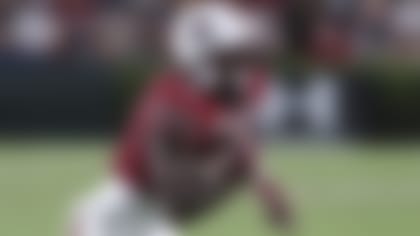With all the hypotheticals and uncertainties immersing the NFL right now, isn't it intriguing that it's a supposed sure thing that might be causing the most consternation as it applies to the draft?
LSU cornerback Patrick Peterson has dreams-are-made-of-this size (6-foot, 219 pounds), ability, competitiveness and character, according to coaches and personnel men. We also hear, almost on a perpetually playing loop from these same football guys, that a team can't ever have enough cornerbacks.
So then why wouldn't Peterson, also a standout returner, be the top overall pick in the draft by the Panthers, who need help just about everywhere?
Baldinger: Peterson is best player
Brian Baldinger believes Patrick Peterson is the best prospect in the draft, and the Panthers would make a mistake by not taking the top player available.
»
Baldinger Mock:
Peterson No. 1
»
Brandt:
Peterson's pro day buzz
»
Blogs:
Peterson blazes at Combine
»
Video:
Peterson's combine workout
»
Photo:
Peterson gets up
The position, it seems, even as valued as it is, at the same time isn't viewed worthy of the No. 1 overall pick. At least that's what history tells us, because a cornerback has never been drafted first overall. Peterson is being talked about as the guy who could break the mold.
"For decision makers who embrace the philosophy of [best available player], regardless of the position, they'll draft the best player," one general manager said. "There are four premium positions: (Quarterback), (right defensive end), (left offensive tackle) and (left cornerback). My belief is to stay with your draft board and take advantage of the NFL draft process in place, by drafting the highest, best available player at your draft slot(s)."
That's easy to say when you're not drafting first. It's easy to say if that elite pass rusher, franchise quarterback or blindside enforcer is also available to build around. The consensus is that there is no consensus top player at those positions, but Peterson is viewed as far and away the top cornerback on the board and, by many personnel men, as the best overall player.
It leaves Carolina in an odd but enviable position, which is why the organization is doing its due diligence on Peterson. New coach Ron Rivera had dinner with Peterson on Sunday night, according to *The New Orleans Times-Picayune*, prior to LSU's pro day Monday, which really was nothing more than a showcase of a handful of position drills. Peterson stood on most of his workout numbers from the NFL Scouting Combine because they were so spectacular. There was no reason to risk having a bad day.
"From everything I've seen, he's the real deal, no red flags, and I've been told he's the type of kid you want to coach," said an NFL assistant coach.
But here's the catch: As good as Peterson is, and as much as he can help a team in the secondary and as a returner, he still plays cornerback. Don't get it twisted, every team wants a great cornerback -- or two or three.
However, as much as a great cornerback like the Jets' Darrelle Revis can impact a game, they can also be taken out of it. This isn't my philosophy. This is what coaches and players say. Offenses can avoid elite cornerbacks by running the ball or throwing to other areas of the field. Sure, that makes it a 10-on-10 game. But if an offense feels their 10 is better than yours, they'll take it. The same philosophy holds for a stud return specialist. Just kick it away from him and you can limit his effectiveness.
An AFC offensive player told me during the season that having to game plan and play against a dominant edge rusher (outside linebacker or end) is far more complicated and challenging than facing a great defensive back. The evidence goes beyond just a player's take. Front seven defenders are valued more than cornerbacks.
Let's look at the past two drafts to emphasize the point.
In 2009, only one cornerback -- Ohio State's Malcolm Jenkins -- was selected in the first round, at No. 14 overall by the Saints. Jenkins now plays safety (and very well I might add). In that same draft, there were eight defensive linemen or linebackers taken in the top 20, including Tyson Jackson at No. 3 to the Chiefs and B.J. Raji at No. 9 to the Packers.
In 2010, the tide changed as Florida cornerback Joe Haden was chosen seventh overall by the Browns, Alabama's Kareem Jackson went at No. 20 to the Texans, Devin McCourty was picked by the Patriots at No. 27 and the Saints selected Florida State's Patrick Robinson with the last pick of the first round. Haden had a solid season, but McCourty was the only standout, and he almost lasted until the second round.
Defensive tackle Ndamukong Suh, the NFL's Defensive Rookie of the Year, was selected second overall by the Lions in that same draft. Ten more front-seven defenders went in the top 20.
What NFL coaches and personnel evaluators will tell you is that rarely do cornerbacks make the immediate impact like a lineman or linebacker can. That's why most teams, when drafting defense first, go with a front-seven player unless they're secure there. Typically, only then will they draft a defensive back.
Carolina needs as much, if not more, help with its front-seven than in its secondary. Factors like scheme, system fit and the type of pressure generated by the defensive front often dictate when and where cornerbacks are drafted, and also helps determine their success. While Peterson is viewed as an excellent coverage player, he might not be ideal in some systems as he would be in others. Teams occasionally shape their schemes around quarterbacks or pass rushers -- but not cornerbacks.
What could also play into using the top pick on a cornerback is his overall difference-making potential. No question Revis makes a difference for the Jets. But does he make as much of a difference as quarterback Mark Sanchez?
This is what Peterson is up against.
Projection game: Two-round mock
Could the Panthers really take CB Patrick Peterson with the top overall pick come April? Pat Kirwan sees such a scenario unfolding in his two-round mock draft. **More ...**
As noted earlier, he's also up against history:
» Revis, considered the best cornerback in the game, was drafted 14th overall in 2007.
» Free agent cornerback Nnamdi Asomugha was selected 31st in 2003 by Oakland.
» Green Bay cornerback Charles Woodson was the No. 4 overall selection by Oakland in 1998.
» Retired cornerback Shawn Springs was the highest drafted cornerback in the modern era at No. 3 overall by Seattle in 1997.
Peterson isn't as good as any of those players at the moment. He might eventually be better than all of them.
Will it be worth using the top overall pick to find out?
Follow Steve Wyche on Twitter @wyche89




